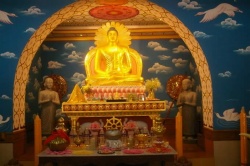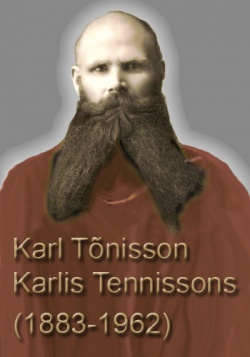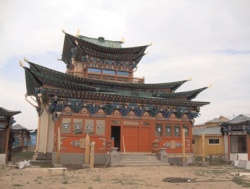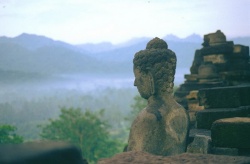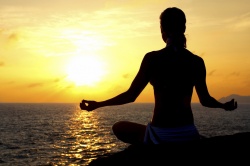Buddhism in the History of Latvia by Marika Laudere
The Buddhism is at the moment one of popular world religions which is practiced in many world countries. Latvia in this connection is not an exception. It is difficult to follow after when information about Buddhism came for the first time to Latvia. We can suppose basing on writing sources that the first news about Buddhism came at the end of 19th century. The overviews about work of Cristian mission in other countries were published at this time, where Buddhism was mentioned also, which was called as „death religion”, which have passivity and lack of life joy. We can explain such a negative attitude in the following way that Buddhism like another religions were valued from position of [[Wikipedia:Christianity|Christianity]].
In spite of such news the year 1908 is considered for account date of Buddhism appearance in Latvia when the brochure of Platon Lebedyev „Buddha, a Prophet of Ancient Indians” and the translation of H. S. Olkot „Buddhist Catechism” translated by well known Latvian writer Augusts Deglavs were published. The interest about Buddhism and another religions has appeared also among Latvian intellectuals who were not satisfied with given answers of [[Wikipedia:Christianity|Christianity]] about life truth. The theme for conversations about Oriental religions and philosophy was widely distributed in the salons since independence in year 1918 where was discussed not only about philosophy of Krishnamurtii, Nietzsche and Schophenhauer but also guests from India were received.
The teaching of Nicholas Roerich (1874 – 1947) is one of main sources where the information about Buddhism was taken where the significant place is showed for Buddhism. The movement centre of Roerich followers was important at that time in Nicholas Roerich. The well-known people in the society existed, for example a poet Rihards Rudzitis (1898 – 1960). The influence of theosophy was expressed brightly in his works.
We can mention an associate professor of Latvian University Aleksandrs Janeks (1891—1970) as one distributor of Buddhism ideas in Latvia. He popularized the Buddhism as the way of objective cognition in his book „The Basics of Buddhism Doctrine” with the Pali canon attached and gave an overview about Buddhism teaching (such themes like suffering, lack of knowledge, the teaching of rebirth and the rule of karma, the eightfold path) and the short information about Buddhism in Europe was given as well therefore by trying to give bigger stress on spread ideas of the author. His next book „Life and Religion” was edited in year 1925. If the first book gives an overview into Buddhism then the second book shows eternity, life and religion itself, purity of doctrine.
The first Buddhism monk in Latvia Karlis Tennisons (1873 – 1962) is the brightest and recognized popularizer in Latvia at the beginning of 20th century. K. Tennison is an essential, although controversial figure in the history of Buddhism in Estonia and Latvia. He was the first who disseminated Buddhism in the Baltic countries.
For the first time he stayed in Riga in the period from 1905 till 1914 however his activities are not noticed. The next visit took place in year 1923 when he gained citizenship of Latvia. He has attracted immediately to himself the attention of Latvian society with his behavior and appearance where he was called as „crazy barefooted” and „fooler of folk”. The attitude of intellectuals against him was also negative, for example professor of Latvian University A. Janeks called him as “cheater of folk” but the professor of Latvian University P. Smidt called him as “Estonian vagabond”.
The Buddhism temple was opened on 15th October 1924 in the result of his activity, in Riga, Balozu street 8 where his learner F.Lustigs from Estonia was ordained in year 1930. The opening of the centre and the spreading of Buddhism ideas has caused a negative attitude in the society and in the press of Latvia what Karlis Tennisons explains educated: “The temple of Buddha belongs to those in Latvia who are not satisfied with indicated places in the skywards and whose soul inclination after higher cognition and truth has not burned out. It belongs only spirit aristocrats”. He wrote in his announcement that “for the simple, dark, uneducated folk mass and for intelligent, educated people and for some scientists as well the right place is Jew synagogue, Muslim mosque, Catholic, Orthodox and Lutheran churches, preaching houses of some sectarians […] and for materialists, internationalists and irreligious people – rooms of different socialistic parties”.
In year 1925 the book of K. Tennison “What does the priest Tennison want to give Latvian people?” was edited in Latvian language what the first of planned 25 books was. However more books were not edited in these series. K. Tennison writes not only about himself, about his started activity in Latvia but also explains some teachings of Buddhism. There is described a temple in St. Petersburg, “life” temple in Tibet and it is mentioned information about Buddha Sakjamuni as well and his written hymn of Latvian Buddhists was published.
Together with immigration of K.Tennison and F. Lustig in 1931 the activities of Buddhists in Latvia have grown calm. The atheism has beeen preached during occupation and all religious activities were limited. It is possible that in the years of „perestroika”, in 1980th years, when the situation has been changed in Latvia and the plateau of soviet regime was observable, the groups of interested people were formed who were searching for new spiritual experience and following to the certain practice of Buddhism. In spite of this, it is doubtful that any spiritual teacher has been visited Latvia in the soviet years. Besides the literature that it is was possible to read about Buddhism was rather literature scientific which was difficult to understood.
A little bit later, at the end of 1980th years, the Buddhism came step by step to Latvia, firstly in the way of spiritual literature where it was possible to get to know brighter about teaching of Buddhism. The summary of lectures of Namkhai Norbu „Talks in Convey” was found among literature. The group of interested people was created in the result in Riga which tried to get in touch with the author of this book which has finished successfully and the first group of Buddhists „The Community of Latvian Buddhists” was registered in 1989 which was renamed into „Padmalinga” community in 1990.
More than 10 years have been passed since creation of first Buddhism community and several Buddhism centres are acting in Latvia at the moment:
- 1.The representing communities of Tibetan Buddhism act in the biggest number: the community of „Padmalinga”, Karma Kagju (the centre of Riga creates it and a small group of people act in Daugavpils), the centre of Ganden and the community of Drikung Kagju which are created by two centres – the centre of Drikung Jamze Ling Dharmachakra in Baltezers and Drikung Ngaden Choling of Riga .
- 2.Theravada Buddhism is represented by community of Theravada Buddhism.
- 3.Dzen Buddhism is practiced in Riga Zen centre (Kwan Um Dzen Buddhism from Korea).
In spite of this that communities of Buddhism are represented by different lines and traditions and each community develops apart from each other as well there can be divided similar tendencies in its activity:
- All communities of Buddhism were acting like informal groups from the first beginning and they were registered officially with the time;
- All groups of Buddhism have a characteristic tendency regarding number of members where the biggest number of people is registered than it is noticed in weekly practices which are collectively made by members of community. 30 – 40 people are acting on average in the communities except Riga Zen centre which is created by approximately 6 people. According to the review of Latvian Ministry of Justice about religious organization in 2010 in Latvia are registered 115 Buddhists in general however its number is bigger because not all communities act as religious organizations but as cultural communities as well.
- The gained information and observations during research confirm that Buddhism in Latvia attracts representatives of different professions and cause an interest among people of different age.
- By trying to distinguish an average age we must make conclusions that 30 – 40 years old people act mostly in the communities although we can meet both young and old members. The children take part sometimes in the meditations because they are taken by parents who practice Buddhism. In difference with another communities of Buddhism the age limitation exists in the community of Theravada Buddhism. The community does not admit persons who are younger 18 years because, as one from the members of the group explained, they depend on their parents thus problems of different can arise.
- All groups of Buddhists in Latvia exist mostly from charities which are collected during different activities or teachings. Some teachings or activities have a certain entrance fee. In spite of this the money of membership is collected also in the community and its community has detected a volume and a principle what and in which way it is paid.
- Latvian centres of Buddhism cooperate mostly with centers of Buddhism which are connected with their Buddhism school, tradition or line. The financial help and an opportunity also to go to study and to practice Buddhism in another centres or temples can appear in cooperation with abroad. Thanks to cooperation with foreign centres in Latvia there is a possibility to receive teachers abroad and arrange their lectures because not all members of groups have an ability to go to any foreign centres and get there a religious experience, for example the instructors come every year to Padmalinga community to read seminars, Yantra yoga, the Vajra dance and give a teachings as well. These are lectures of traveling teachers in the community of Karma Kagju what are planned every year. The same teachings take place also in the rest of rooms of the communities.
By reaching a certain development ethap the communities of Buddhism began to involve into social activities. Exactly through them communities of Buddhism try to address Latvian society, rouse interest among people by offering an opportunity in such a way to visit communities and take part in meditations. One of the main activities of Buddhism communities is a religious practice which connects existent
people. In this connection communities of Latvian Buddhists try to hold on main principles of Buddhism and accomplish a practice of Buddhism according to main conceptions of certain Buddhism school. The religious activity, firstly, is made by weekly practices and meditations, secondly, teachings of different way which are organized mostly in the rooms of community during visit of Buddhism teachers or
monks. Usually their visit is limited with the giving of teaching in a certain community, but sometimes public lectures are arranged for which needs are rented brighter rooms. These lectures have general characteristics and their aim is to provide information about Buddhism and its teaching, as well its usage in everyday life. As a rule at the end of such lectures there is an opportunity for the interested to ask their questions
The members of community themselves read sometimes lectures. In this manner one from the members of Ganden centre gets masters education already the third year in the institute of lama Tsongkhapa in Italy and by coming to Latvia gives lectures about basics of Buddhism in the rooms of community.
The members of Buddhism community practice also lasting retreats which are organized mostly in countrysides of Latvia, for example, Ganden centre has its own meditation centre „Jiga Chodzin” in the countryside of Latvia or they are arranged outside of Latvia. In this manner the representatives of Riga Zen centre go to make retreats to any Kwan Um Buddhism centres from Europe countries.
The healing is especially stressed in the line of Drikung Kagju. In this connection there are also efforts to follow this tradition in Latvia. Near to the Drikung Kagju community in Baltezers is built a Tibetan Yoga and Healing centre where some of community members are involved. The healers from Tibet come there regularly, they make a diagnostic and correction of patients and also take part in educational
programs. There also offer different health treatment, for example, various types of massage. The opportunity to get education in various programs is provided there, e.g. “Specialist of Yoga”, “Therapist of Yoga” and “Master of Yoga”. International Yoga Healing Federation, Federation of Baltic Yoga, the representatives of Latvian professional and other leading specialists of yoga on the international level took part in the
development of this educational program. The certificated doctors and healers of Tibet lead lessons. The teaching is implemented in the way of practical lessons and seminars; distance and interactive teaching is also applied. The teaching centre of Tibetan Healing and Yoga
Education Centre is the first educational establishment in the European Union which has the right to teach specialists of yoga on the state level. The lectures are given by certificated doctors and healers of Tibet. After finish of studies the new specialists get a certificate of professional qualification which allows to work as self – employed person.
There are also layed the foundation for building the stupa of Enlightenment which is planned as 10 metres high two-storey building but because of economical crisis this project is stopped for some while.
The group of Drikung Kagju is not only which is occupied with education. Since 2011 year May of 2th Ganden centre has began 2 years teaching program “Discovering Buddhism” which is a created Buddhism teaching program of many Mahayana traditions teachers and program coordinators. The program last for 2 years. After finish of full course students will get a certificate which is created by 14 themes. Each theme includes from 4 till 5 lectures, meditation practices, and acquaintance with texts and participation in retreats. The aim of the programme is to give a deeper understanding about Buddhism teaching and meditation.
One of educational activities about Buddhism which took place already the 6th time in Latvia is Buddhism Days in Latvia which are organized by the centre of Karma Kagju since 2006. During these days there is a possibility to visit lectures of traveling teachers about different themes, see documentaries made by Karma Kagju and different exhibitions are made as well. Last year there was a possibility to see an exhibition of photos “Happy man” and this one week long activity was finished by two days long course of lectures with lama Ole Nidal.
The centre of Karma Kagju is engaged in translation and edition of Ole Nidal books into the Latvian language in this way by giving an opportunity to get to know with the teaching of Buddhism. By now all meditations and the main book of Ole Nidal “The Way Things Are???? A Living Approach to Buddhism for Today’s world” have been translated.
The main sence is devoted to charity activities in the groups of Buddhism. There are collected clothes and toys which are intended for orphanages and care homes. The communities of Drikung Kagju also pay attention to supporting poor people and orphans. People from the communities of Drikung Kagju and Ganden visit animal’s shelters to donate food and money for them.
These communities of Buddhism are engaged also in different international projects which have mostly a charity aim. One of the projects that have attracted the attention of Latvian society is Maitreya project (in year 2007 and 2009) and its organisation was coordinated by Ganden centre but other representatives of Buddhist communities were invited for their help.
Another example is that communities of Drikung Kagju have hosted monks of Tibet Buddhism from Ladaka with concert programme „Himalaya Tour 2010” in September 2010. This programme included the Exhibition of Sacral Buddhism pictures – thanka, the concert of sacral dancing and rituals of Tibetan Buddhism and creation of Dzambala sand mandala.
We must make conclusions about existence of Buddhism in Latvia that beginnings of Buddhism in Latvia must be searched at the beginning of 20th century when Buddhism came to Latvia step by step in different ways in the way of books and brochures and with the help of preachers as well. In spite of this the big interest was not noticed among people except intellectuals who had more opportunities to follow to
new changes in religious field and who engaged in new religious searchings more easily. This can be explained in the following way that firstly the teaching of Buddhism was not almost available for society, secondly [[Wikipedia:Christianity|Christianity]] took deeply roots in the society. Consequently in spite of this that Buddhism was well-known at the beginning of 20th century but it has not gained the big popularity.
The different situation is watched nowadays when ideas of Buddhism started to revive at the end of 1980s. After fall of USSR Buddhists in Latvia gained religious freedom and their communities were adapted successfully into multireligious society of Latvia. The great
success is gained: several communities are acting in Latvia, different activities are arranged where monks are participating also and teachers from Asia and Europe. We can say that Buddhism has created a stable place in religious and cultural
space of Latvia. It gets the biggest influence together with new religious movements in Latvia. Often visits of communities confirm this, successful activity of groups and dissemination of Buddhism ideas in the society as well.
Source
Author: Marika Laudere
buddhismandaustralia.com
